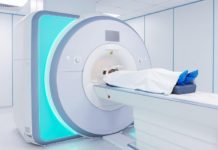GE Healthcare’s Discovery NM/CT 670 CZT is the world’s first general purpose, ultra-high resolution SPECT/CT imaging system that can reduce injected dose or scan time by up to 50%*
HHM Global/Press releases/-Doctors and researchers at Barnes-Jewish Hospital and Washington University in St. Louis may be able to better diagnose and monitor diseases at a functional level with GE Healthcare’s next-generation SPECT/CT system, Discovery NM/CT 670 CZT. The new SPECT/CT is the world’s first general purpose, ultra-high resolution SPECT/CT imaging system with a new digital detector powered by cadmium zinc telluride (CZT) technology. This is one of the biggest nuclear medicine technological breakthroughs since the introduction of the first general purpose gamma camera designed by Hal Anger in 1957.
SPECT/CT exams are performed to assess the functionality of organs and play a key role in the diagnosis and monitoring of a multitude of diseases. GE Healthcare’s new system is equipped with CZT technology that enables direct conversion of photons into a digital signal therefore making the technology more efficient. Until now, CZT technology has been limited to organ-dedicated devices, whereas Discovery NM/CT 670 CZT is the first to allow doctors to perform exams on every organ, including whole-body exams.
This technology is intended to help improve clinical efficacy and patient experience. Improved efficacy will allow doctors to detect smaller lesions2 and quantify them more accurately3 due to the increased spatial and contrast resolution. This may have a significant role in assessing and monitoring responses to therapies. Having the ability to complete multiple scans in a single visit and reduce the dose injected or the scan time by 50 percent* will improve patient experience. Optimizing the duration of the exams or the injected dose represents not only an improvement for the patient experience, but also helps increase the operational and financial efficiency of hospitals.
“We were able to do an in-field upgrade to the Discovery NM/CT 670 CZT, which was a faster and more efficient way to enable us to leverage the new CZT detector. We believe this new system will allow us to see improvements in lesion detectability and will increase the utility of SPECT/CT; we will also look to see how we can reduce scan time, lower dose or both, while maintaining image quality,” said Dr. Barry A. Siegel, Professor of Radiology and Medicine, Senior Vice-chair and Division Director of Nuclear Medicine at Mallinckrodt Institute of Radiology at Washington University in St. Louis. “We look forward to doing research on SPECT/CT quantification, as accurate and reproducible quantification will be increasingly important in nuclear medicine.”
“We are thrilled to be collaborating with Barnes-Jewish Hospital and Washington University to advance nuclear medicine. We believe this new technology will significantly improve the way exams are performed today and enable new areas of exploration for researchers who are looking at ways to optimize imaging protocols and gain additional insights about patients’ condition,” explains Nathan Hermony, General Manager of Nuclear Medicine at GE Healthcare.
Researchers have identified clinical scenarios where the combination of multiple SPECT tracers could aid physicians in diagnosing and giving much better and more specific reports in difficult patient conditions. However, performing such multi-isotope exams is quite challenging on conventional cameras. Multiple isotope exams could offer a greater insight into the diagnosis and monitoring responses to treatments. With GE’s new Discovery NM/CT 670 CZT, clinicians will be able to simultaneously visualize and analyse multiple physiological processes in a patient, gaining insights into multiple dimensions of the patient’s anatomy and physiology at the same time using the hybrid SPECT/CT that GE Healthcare was the first to bring to the industry.
About GE Healthcare
GE Healthcare provides transformational medical technologies and services to meet the demand for increased access, enhanced quality and more affordable healthcare around the world. GE Healthcare (NYSE: GE) works on things that matter – great people and technologies taking on tough challenges. From medical imaging, software & IT, patient monitoring and diagnostics to drug discovery, biopharmaceutical manufacturing technologies and performance improvement solutions GE Healthcare helps medical professionals deliver great healthcare to their patients. http://www.gehealthcare.com
* Together with Evolution technology1.
1In clinical practice, Evolution options1a (Evolution for Bone, Evolution for Cardiac, Evolution for Bone Planar) and Evolution Toolkit1b are recommended for use following consultation of a Nuclear Medicine physician, physicist and/or application specialist to determine the appropriate dose or scan time reduction to obtain diagnostic image quality for a particular clinical task, depending on the protocol adopted by the clinical site.
1a Evolution Options – Evolution claims are supported by simulation of count statistics using default factory protocols and imaging of 99mTc based radiotracers with LEHR collimator on anthropomorphic phantom or realistic NCAT – SIMSET phantom followed by quantitative and qualitative images comparison.
1b Evolution Toolkit – Evolution Toolkit claims are supported by simulation of full count statistics using lesion simulation phantom images based on various radiotracers and collimators and by showing that SPECT image quality reconstructed with Evolution Toolkit provide equivalent clinical information but have better signal-to-noise, contrast, and lesion resolution compare to the images reconstructed with FBP / OSEM.
2 In clinical practice, the use of Discovery NM/CT 670 CZT may improve lesions detectability depending on the clinical task, patient size, anatomical location and clinical practice. A consultation with a radiologist and a physicist should be made to determine the appropriate dose or scan time to obtain diagnostic image quality for the particular clinical task.
3 In clinical practice, the use of Discovery NM/CT 670 CZT may improve quantification of lesions larger than 5.5mL, depending on the clinical task, patient size, anatomical location and clinical practice. A consultation with a radiologist and a physicist should be made to determine the appropriate dose or scan time to obtain the claimed quantification accuracy for the particular clinical task.























